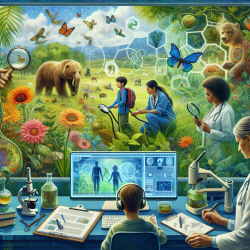Introduction
As practitioners dedicated to fostering optimal child development, it is crucial to integrate findings from diverse scientific fields into our practice. One such field is child environmental health (CEH) science, which has identified significant impacts of environmental toxicants on child development. The research article "Environmental Contaminants and Child Development: Developmentally-Informed Opportunities and Recommendations for Integrating and Informing Child Environmental Health Science" by Alison L. Miller provides valuable insights and recommendations for practitioners. This blog will explore how these findings can be applied to improve child outcomes.
Understanding the Impact of Environmental Contaminants
CEH science has documented the adverse effects of early life exposures to environmental toxicants such as air pollution, water contaminants, and pesticides. These exposures can lead to long-term health issues and developmental delays. Importantly, these risks are disproportionately higher in marginalized communities, necessitating an equitable approach to intervention.
Developmentally-Informed Conceptual Models
Practitioners can enhance their understanding of how environmental exposures impact child development by utilizing developmentally-informed conceptual models. These models consider the complex interplay of biological, behavioral, and social-ecological factors. By applying these models, practitioners can better identify the nuanced impacts of toxicants and develop targeted interventions.
Applying Creative and Rigorous Methods
To effectively address the subtle impacts of environmental exposures, practitioners should employ creative and sophisticated assessment methods. This includes using developmentally-sensitive tools to capture bio-behavioral changes and employing innovative measurement strategies to assess individual exposures. Engaging communities in these efforts can also drive meaningful change.
Integrating Developmentally-Sensitive Interventions
Interventions should be tailored to the developmental stage of the child, considering periods of heightened vulnerability such as early childhood and adolescence. Practitioners can implement interventions that enhance environmental health literacy among caregivers and communities, empowering them to advocate for safer environments.
Establishing Interdisciplinary Collaborations
Collaboration across disciplines and sectors is essential to translate CEH findings into practice. By partnering with CEH scientists, policymakers, and community stakeholders, practitioners can develop comprehensive strategies to mitigate environmental risks and promote child development. Such collaborations can also facilitate the translation of animal model findings to human contexts, enhancing the relevance and applicability of research.
Conclusion
Integrating CEH science into child development practice offers a powerful opportunity to improve outcomes for children, particularly those in marginalized communities. By adopting developmentally-informed models, employing rigorous methods, and fostering interdisciplinary collaborations, practitioners can play a pivotal role in mitigating the impacts of environmental toxicants on child development. To delve deeper into the original research, please follow this link: Environmental contaminants and child development: Developmentally-informed opportunities and recommendations for integrating and informing child environmental health science.










